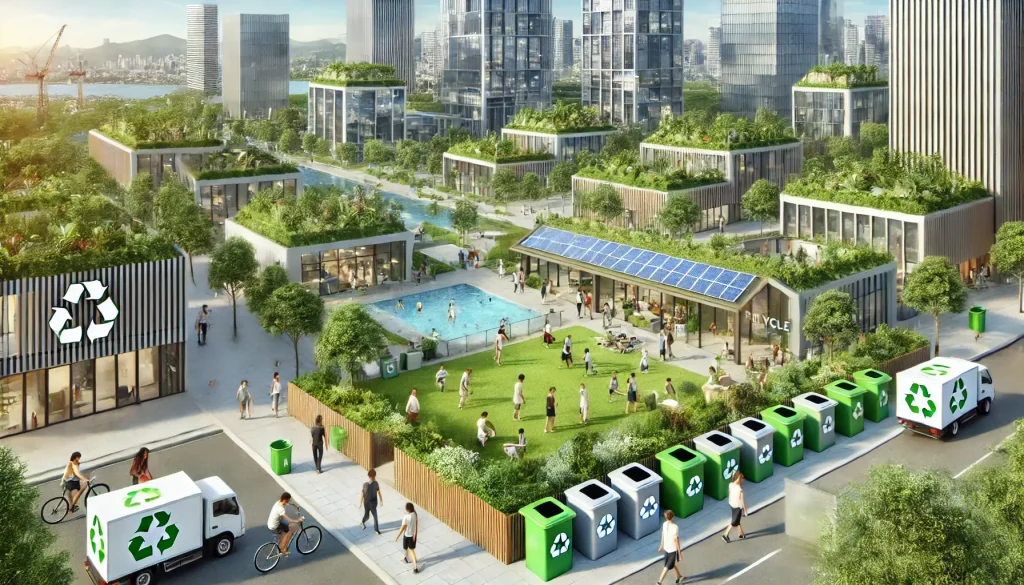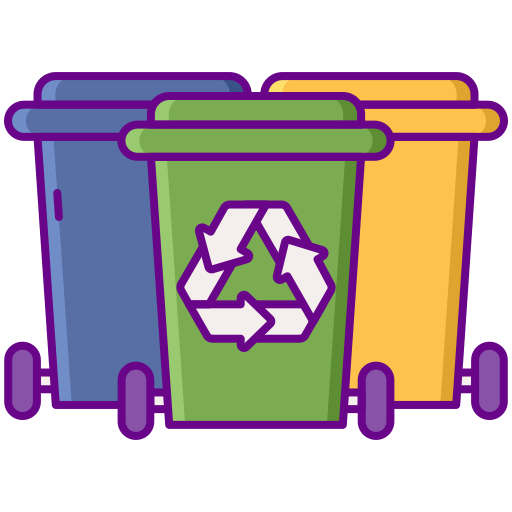Sustainable urban development requires a holistic approach that carefully integrates environmental, social, and economic factors. One key element in achieving this harmony is recycling. When we effectively integrate recycling programs into urban planning, we create a balance between resource conservation and modern infrastructure, paving the way for cities that are not only thriving but also eco-friendly.

Index
The Role of Recycling in Urban Sustainability
Urban environments are hubs of economic activity and population density, but they also generate enormous amounts of waste. Recycling plays a critical role in reducing this waste and conserving resources. By transforming discarded materials into valuable products, cities can maintain a balance between development and environmental protection.
- Waste Reduction: Recycling reduces the volume of waste that ends up in landfills, minimizing environmental pollution and conserving land.
- Resource Conservation: By reusing materials, recycling lessens the need for extracting virgin resources, thereby protecting natural ecosystems.
- Energy Savings: Manufacturing products from recycled materials generally consumes less energy than producing them from new inputs, reducing greenhouse gas emissions.
- Economic Efficiency: Recycling creates jobs in collection, processing, and remanufacturing, contributing to a resilient, sustainable urban economy.
These benefits demonstrate how recycling is an essential tool for urban planners striving to create a balance between growth and sustainability.
Key Elements for Achieving Balance in Urban Recycling
To successfully integrate recycling into sustainable urban development, it is vital to focus on several key elements that work together to maintain equilibrium:
1. Comprehensive Waste Management Systems
Establishing an effective waste management system is the first step toward a sustainable urban environment. This includes:
- Efficient Collection and Segregation: Ensuring that recyclable materials are collected separately at the source prevents contamination and improves the quality of recycled products.
- State-of-the-Art Processing Facilities: Modern recycling centers equipped with advanced sorting and processing technologies maximize material recovery.
- Integrated Infrastructure: Developing a seamless connection between waste collection points, processing facilities, and end-user markets helps maintain a continuous flow of recyclable materials throughout the urban area.
A well-coordinated waste management system ensures that recycling becomes an integral part of urban living, helping cities balance progress with sustainability.
2. Urban Planning and Policy Integration
Urban planners play a crucial role in incorporating recycling into city infrastructure. This involves:
- Designing for Recyclability: Incorporating recycling facilities into new urban developments ensures that waste management is built into the city’s foundation.
- Zoning and Incentives: Municipal policies can promote recycling by providing incentives for green buildings and sustainable waste management practices.
- Public-Private Partnerships: Collaborations between government entities and private companies can drive innovation and investment in recycling infrastructure, ensuring that recycling initiatives are both economically and environmentally sustainable.
Integrating recycling into urban planning creates a framework where sustainable development and resource management balance each other, leading to healthier, more resilient communities.
3. Community Engagement and Education
A thriving urban recycling program depends on active participation from the community. Strategies include:
- Educational Campaigns: Informing residents about the benefits of recycling and proper waste segregation encourages behavioral change.
- Local Recycling Programs: Establishing accessible recycling centers and incentivizing participation through rewards and recognition fosters community involvement.
- Digital Platforms: Mobile apps and online portals that track recycling contributions and provide real-time information help residents stay engaged and motivated.
Engaged communities are the backbone of sustainable urban development. When citizens understand and embrace recycling, they contribute to an urban ecosystem where economic growth and environmental care balance harmoniously.
4. Technological Advancements
Innovative technologies play a pivotal role in modernizing recycling processes and achieving efficiency. Key technologies include:
- IoT and Smart Sensors: These devices monitor waste levels and optimize collection routes, ensuring that recyclable materials are efficiently processed.
- Artificial Intelligence (AI): AI-driven sorting systems enhance the accuracy of material separation, increasing the quality and quantity of recovered materials.
- Blockchain Technology: Transparent, digital tracking of recycling operations builds trust and ensures accountability in the recycling process.
- Chemical and Mechanical Recycling: Advanced recycling methods allow even complex materials, such as multi-layer plastics, to be broken down and repurposed.
By embracing these technological innovations, cities can significantly improve recycling efficiency, helping to balance urban development with resource conservation.
Environmental, Economic, and Social Impacts
Integrating recycling into sustainable urban development yields benefits across multiple dimensions:
Environmental Impact
- Resource Conservation: Recycling reduces the need for new raw materials, preserving forests, minerals, and water resources.
- Emission Reduction: Energy savings from recycling lower greenhouse gas emissions, contributing to improved air quality and climate stability.
- Biodiversity Protection: Less resource extraction means reduced environmental degradation, protecting ecosystems and promoting biodiversity.
Economic Impact
- Cost Savings: Recycling helps lower production costs by reducing reliance on virgin materials.
- Job Creation: The recycling industry creates diverse employment opportunities, from waste collection to advanced processing.
- Innovation and Market Growth: As urban recycling initiatives grow, they stimulate market innovation, leading to the development of new, sustainable products and technologies.
Social Impact
- Community Health: Reduced waste and pollution improve the overall health of urban populations, leading to cleaner air and water.
- Civic Engagement: Recycling programs empower citizens to contribute to environmental sustainability, fostering a sense of community and shared responsibility.
- Educational Opportunities: Public recycling initiatives provide valuable learning experiences, encouraging future generations to adopt sustainable practices.
When urban areas effectively integrate recycling, they create a balance that supports environmental stewardship, economic growth, and social well-being.
Case Studies: Achieving Balance in Urban Recycling
Case Study 1: Metropolitan Recycling Initiative
A major metropolitan area revamped its waste management system by integrating smart recycling bins equipped with IoT sensors. The initiative increased recycling rates by 45%, reduced landfill waste significantly, and lowered the city’s carbon footprint. This project illustrates how technology-driven recycling can create a balance between urban development and environmental preservation.
Case Study 2: Green Urban Development Project
An urban development project incorporated on-site recycling facilities as a key feature of a new eco-friendly neighborhood. By designing buildings with integrated waste management systems and offering incentives for sustainable living, the project successfully reduced waste, promoted resource conservation, and fostered a strong sense of community. The project serves as a model for how urban planning and recycling can work together to balance growth with sustainability.
Case Study 3: Community-Driven Recycling Hub
In a suburban community, local leaders established a recycling hub that provided accessible drop-off points, educational workshops, and digital tools to track recycling efforts. The hub increased participation among residents, reduced waste disposal costs, and improved local environmental quality. This grassroots initiative highlights the power of community engagement in creating a sustainable urban balance.
Future Directions and Innovations
As cities continue to evolve, so too will the strategies for integrating recycling into sustainable urban development. Future trends include:
Advancements in Digital Technologies
- Enhanced IoT Networks: Future IoT solutions will offer even more precise waste monitoring and optimized logistics, further streamlining recycling operations.
- AI-Powered Optimization: As AI algorithms become more sophisticated, they will enable dynamic adjustments in recycling processes, maximizing efficiency and reducing costs.
- Blockchain Integration: Wider adoption of blockchain will ensure complete transparency and traceability, building trust in recycling initiatives and ensuring compliance with sustainability standards.
Policy and Collaborative Innovations
- Stronger Regulatory Frameworks: Governments are expected to implement more robust recycling mandates and incentives, ensuring that urban recycling remains a priority.
- Public-Private Partnerships: Increased collaboration between public entities, private companies, and community organizations will drive investments in sustainable infrastructure and foster innovative recycling solutions.
- Global Recycling Standards: The development of international standards for recycling will help harmonize practices worldwide, ensuring that sustainable urban development is achievable on a global scale.
Educational and Social Innovations
- Expanded Community Programs: Greater emphasis on public education and community-based recycling initiatives will empower citizens to actively participate in sustainable practices.
- Digital Engagement Platforms: Enhanced mobile apps and online communities will provide real-time feedback, rewards, and educational resources, encouraging widespread adoption of recycling habits.
- Cultural Integration: As recycling becomes a core component of urban identity, we can expect to see increased incorporation of recycled art and design in public spaces, creating a visible reminder of our commitment to sustainability.
Conclusion: Achieving a Sustainable Balance
Integrating recycling into sustainable urban development is essential for building eco-friendly communities that flourish economically, socially, and environmentally. By adopting innovative recycling technologies, engaging communities, and implementing forward-thinking urban planning, cities can achieve a balance that conserves natural resources, reduces waste, and promotes long-term sustainability.
At Eu Setor, we are dedicated to pioneering sustainable practices that help urban areas balance growth with environmental stewardship. We invite you to join us on this transformative journey—explore advanced recycling strategies, engage with local initiatives, and contribute to a future where urban development and resource conservation go hand in hand.
For more insights, detailed guides, and inspiration on integrating recycling into sustainable urban development, please visit our website at eu.setorreciclagem.com.br and become part of the Eu Setor community. Let’s work together to create cities that not only grow but also balance progress with the planet’s well-being, ensuring a greener, more sustainable future for all.
